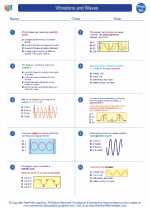Vibrations and Waves -> communication
Communication
Communication is the process of exchanging information, ideas, and thoughts between individuals or groups. It is an essential aspect of human interaction and plays a crucial role in various aspects of life, including personal relationships, business, education, and more.
Types of Communication
There are several types of communication, including:
- Verbal Communication: This involves the use of spoken or written words to convey a message. It includes face-to-face conversations, phone calls, emails, and more.
- Nonverbal Communication: This type of communication involves body language, facial expressions, gestures, and other nonverbal cues to convey meaning.
- Visual Communication: Visual communication uses images, graphs, charts, and other visual aids to convey information.
- Written Communication: This type of communication involves the use of written words, such as letters, memos, reports, and other written documents.
- Interpersonal Communication: Interpersonal communication occurs between two or more people and is essential for building and maintaining relationships.
- Mass Communication: Mass communication involves the dissemination of information to a large audience through various media channels, such as TV, radio, newspapers, and the internet.
Elements of Communication
Effective communication involves several key elements:
- Sender: The sender is the person or entity initiating the communication by conveying a message.
- Message: The message is the information, idea, or thought being transmitted from the sender to the receiver.
- Channel: The channel is the medium through which the message is transmitted, such as face-to-face, phone, email, or other communication tools.
- Receiver: The receiver is the person or group for whom the message is intended.
- Feedback: Feedback is the response or reaction from the receiver back to the sender, indicating whether the message was understood.
- Context: The context refers to the circumstances and environment in which the communication takes place, including cultural, social, and situational factors.
Barriers to Communication
There are several barriers that can hinder effective communication, including:
- Language barriers: Differences in language and dialects can lead to misunderstandings and misinterpretations.
- Cultural barriers: Variances in cultural norms, values, and customs can impact the interpretation of messages.
- Physical barriers: Environmental factors, such as noise, distance, or visual obstructions, can impede communication.
- Psychological barriers: Emotional states, preconceptions, and biases can affect how a message is received and understood.
- Technological barriers: Issues with communication tools and technology can disrupt the flow of information.
Effective Communication Skills
To improve communication, individuals can develop and hone the following skills:
- Active Listening: Paying full attention to the speaker and seeking to understand their message.
- Clarity and Conciseness: Expressing ideas clearly and succinctly to avoid confusion.
- Empathy: Understanding and acknowledging the feelings and perspectives of others.
- Nonverbal Communication: Being aware of and using nonverbal cues to enhance understanding.
- Feedback: Providing and receiving constructive feedback to improve communication.
- Adaptability: Adapting communication style to suit the needs and preferences of the audience.
Study Guide
When studying communication, it is important to understand the various types of communication, the key elements involved, barriers that can impede effective communication, and the skills needed to enhance communication. To gain a deeper understanding, consider the following study tips:
- Review and understand the different types of communication and their characteristics.
- Examine the elements of communication and how they interact in the communication process.
- Explore real-life examples of communication barriers and how they can be overcome.
- Practice active listening and observe nonverbal communication in everyday interactions.
- Engage in role-playing scenarios to develop effective communication skills.
- Research and analyze case studies of successful and unsuccessful communication in various contexts.
By studying and practicing these concepts, you can enhance your communication skills and become a more effective communicator in both personal and professional settings.
.◂Physics Worksheets and Study Guides High School. Vibrations and Waves

 Worksheet/Answer key
Worksheet/Answer key
 Worksheet/Answer key
Worksheet/Answer key
 Worksheet/Answer key
Worksheet/Answer key
